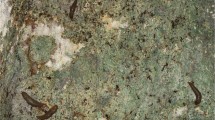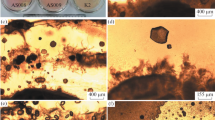Abstract
The colonisation of ornamental marble statues in theBoboli Gardens of Florence (Italy) by photosyntheticmicro-organisms was investigated. The greenmicroalga Coccomyxa was the first colonizer ofnewly restored marble surfaces, appearing one yearafter the periodic cleaning and restoration of thestatues. Two years after restoration this alga gaverise to very thin green biofilms, with densitiesreaching about 3 × 102 cells cm-2. Later,the biofilms were enriched by cyanobacterial forms,which became dominant. In about six years, aphotosynthetic microbial community, amounting to about3 × 104 cells cm-2, and structurally similarto that occurring on the unrestored statues wasdeveloped. This epilithic community showed amarked biodiversity; the main representative formsincluded Chroococcidiopsis, Leptolyngbya,Pleurocapsa, Coccomyxa and Apatococcus.Coccomyxa initiated the colonisation of themarble surfaces, favoured in this process by itsfacultative oligotrophic capacity and high cellsurface hydrophobicity, combined with tolerance ofhigh light intensity. The other investigated isolatedstrains did not show this set of features. Thesecretion of polysaccharidic substances and cellsurface hydrophobicity enhancing the capacity toadhere, favoured permanent colonisation of thecyanobacterial population. Indeed, the majority of thecyanobacterial strains (90%), were shown to besurrounded by exopolysaccharidic envelops, whichcontributed to the formation of stable microbialbiofilms, and possessed variable cell surfacehydrophobicity.
Similar content being viewed by others
References
Albertano P, Urzí C (1999) Structural interactions among epilithic cyanobacteria and heterotrophic microorganisms in Roman hypogea. Microb. Ecol. 38: 24-252.
Ariño X, Saiz-Jimenez C (1996) Colonization and deterioration process in Roman mortars by cyanobacteria, algae and lichens. Aerobiologia 12: 9-18.
Arroyo G, Arroyo I, Vivar C (1995) Microbiological analysis of mortars from the church of San Juan del Mercado at Benavente, Spain. Sci. tot. Environ. 167: 221-229.
Bourrelly P (1966) Les Algues d'Eau Douce. N Boubée & Co, Paris.
Castenholz RW, Waterbury JB (1989) Group 1. Cyanobacteria. In Staley JT, Bryant MP, Pfennig N, Holt JG (eds), Bergey's Manual of Systematic Bacteriology, 3, Williams & Wilkins, Baltimore, pp. 1710-1799.
Crayton MA (1982) A comparative study of volvocacean matrix polysaccharides. J. Phycol. 18: 336-344.
Diakumaku E, Gorbushina AA, Krumbein WE, Panina L, Soukharjevski S (1995) Black fungi in marble and limestones-an aesthetical, chemical and physical problem for the conservation of monuments. Sci. tot. Environ. 167: 295-304.
Fattom A, Shilo M (1984) Hydrophobicity as an adhesion mechanism of benthic cyanobacteria. Appl. envir. Microbiol. 47: 135-143.
Favali FA, Barbieri N, Bassi M (1978) A green alga growing on a plastic film used to protect archaeological remains. Int. Biodeterior. Bull. 14: 89-93.
Flores M., Lorenzo J., Gòmez-Alarcòn G., (1997). Algae and bacteria on historic monuments at Alcala de Henares, Spain. Int. Biodeterior. Biodegrad. 40: 241-246.
Gómez-Alarcón G, Muñoz M, Ariño X, Ortega-Calvo JJ (1995) Microbial communities in weathered sandstones: the case of Carrascosa del Campo church, Spain. Sci. tot. Environ. 167: 249-254.
Griffin PS, Indictor N, Koestler RJ (1991) The biodeterioration of stone: a review of deterioration mechanism, conservation case histories and treatment. Int. Biodeterior. 28: 187-207.
Guillitte O, Dreesen R (1995) Laboratory chamber studies and petrographical analysis as bioreceptivity assessment tools of building materials. Sci. tot. Environ. 167: 365-374.
Krumbein WE (1972) Rôle des microorganismes dans la genèse, la diagenèse et la dégradation des roches en place. Rev. Biol. Sol. 9: 83-319.
Krumbein WE (1988) Microbial interactions with mineral materials. In Houghton DR, Smith RN, Eggins HOW (eds), Biodeterioration, 7, Elsevier Applied Science, London, pp. 78-100.
Ortega-Calvo JJ, Ariño X, Hernandez-Marine M, Saiz-Jimenez C (1995) Factors affecting the weathering and colonisation of monuments by phototrophic microorganisms. Sci. tot. Environ. 167: 329-341.
Ortega-Calvo JJ, Hernandez-Marine M, Saiz-Jimenez C (1991) Biodeterioration of building material by cyanobacteria and algae. Int. Biodeterior. 28: 165-185.
Ortega-Calvo JJ, Sanchez-Castillo PM, Hernandez-Marine M, Saiz-Jimenez C (1993) Isolation and characterization of epilithic chlorophytes and cyanobacteria from two Spanish cathedrals (Salamanca and Toledo). Nova Hedwigia 57: 239-253.
Parson TR, Strickland JHD (1963) Discussion of spectrophotometric determination of marine plant pigments, with revised equation ascertaining chlorophyll and carotenoids. J. mar. Res. 21: 155-162.
Pochon J, Tardieux P (1962) Techniques d'Analyse en Microbiologie du Sol. Editions De La Tourelle Saint-Mandé Seine, 110 pp.
Realini M, Negrotti R, Appollonia L, Vaudan D (1995) Deposition of particulate matter on stone surfaces: an experimental veri-fication of its effects on Carrara marble. Sci. tot. Environ. 167: 67-72.
Rippka R (1988) Isolation and purification of cyanobacteria. In Parker L, Glazer AN (eds), Cyanobacteria, Meth. Enzymol. 167, Academic Press, San Diego, pp. 3-27.
Rippka R, Deruelles J, Waterbury JB, Herdman JB, and Stanier RY (1979) Generic assignment, strains history and properties of pure cultures of cyanobacteria. J. gen. Microbiol. 111: 1-61.
Tiano P, Accolla P, Tomaselli L (1994) Biocidal treatments on algal biocoenosis control of the lasting activity. Sci. Technol. Cult. Heritage 3: 89-94.
Tiano P, Accolla P, Tomaselli L (1995) Phototrophic biodeteriogens on lithoid surfaces: an ecological study. Microb. Ecol. 29: 299-309.
Wollenzien U, de Hoog GS, Krumbein WE, Urzí C (1995) On the isolation of microcolonial fungi occurring on and in marble and other calcareous rocks. Sci. tot. Environ. 167: 287-294.
Author information
Authors and Affiliations
Rights and permissions
About this article
Cite this article
Lamenti, G., Tiano, P. & Tomaselli, L. Biodeterioration of ornamental marble statues in the Boboli Gardens (Florence, Italy). Journal of Applied Phycology 12, 427–433 (2000). https://doi.org/10.1023/A:1008135501265
Issue Date:
DOI: https://doi.org/10.1023/A:1008135501265




